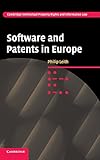Software and patents in Europe / Philip Leith. electronic resource
Material type: TextSeries: Cambridge intellectual property and information lawPublication details: Cambridge, UK ; New York : Cambridge University Press, 2007.Description: viii, 203 p. : ill. ; 24 cmISBN:
TextSeries: Cambridge intellectual property and information lawPublication details: Cambridge, UK ; New York : Cambridge University Press, 2007.Description: viii, 203 p. : ill. ; 24 cmISBN: - 9780521868396 (hbk.)
- 0521868394 (hbk.)
- 0511366361
- 9780511366369
- 346.240486 22
- KJE2725 .L45 2007
- 86.33
| Item type | Current library | Collection | Call number | URL | Status | Date due | Barcode | Item holds |
|---|---|---|---|---|---|---|---|---|
 e-book
e-book
|
KNCHR Library SharePoint | Non-Fiction | KJE2725 .L45 2007 (Browse shelf(Opens below)) | Link to resource | Available |
Includes bibliographical references and index.
Software as machine -- Software as software -- policy arguments -- Software patent examination -- Holding the line: algorithms, business methods and other computing ogres -- The third way: between patent and copyright? -- Conclusion: dealing with and harmonising 'radical' technologies
The computer program exclusion from Article 52 of the European Patent Convention (EPC) proved impossible to uphold as industry moved over to digital technology, and the Boards of Appeal of the European Patent Organisation (EPO) felt emboldened to circumvent the EPC in Vicom by creating the legal fiction of 'technical effect'. This 'engineer's solution' emphasised that protection should be available for a device, a situation which has led to software and business methods being protected throughout Europe when the form of application, rather than the substance, is acceptable. Since the Article 52 exclusion has effectively vanished, this text examines what makes examination of software invention difficult and what leads to such energetic opposition to protecting inventive activity in the software field. Leith advocates a more programming-centric approach, which recognises that software examination requires different strategies from that of other technical fields.
Table of contents also issued online.

There are no comments on this title.